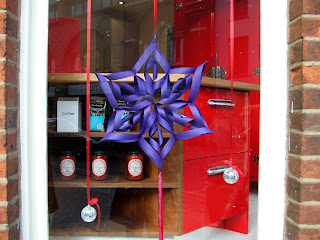 |
| Wet pages |
 |
| Dry pages |
We then mixed up 4 colours of Brusho (powdered pigment ink) and painted both sides of the pieces and left them in a stack, overlapping at angles to let them dry.
This results in random blotches and mottles as the paint and water seep through the stack. Next week we will learn how to stitch the pages together to make the book.
Then we moved on to create a piece of 'lace' using water-soluable fabric. This stuff comes in a number of forms but we were using something called 'Romeo', which looks like thick cling-film. We snipped bits of fabric and thread onto a piece of the film and then pinned another piece on top, ensuring that there were still some gaps.
Using the free-motion embroidery technique we stitched all the way around the edge and then across the centres to secure the fabric snips in their plastic envelope.
 |
| Back |
A quick rinse in hot water dissolves the film and you are left with a limp looking coloured spider's web! It is re-shaped as you spread it out to dry.
 |
| Front |
Although it is very lacy it is amazing how different it is on the front and back. The lace has remained quite stiff too - I don't know if this would disappear if I rinsed it more thoroughly.
Our tutor showed us how to make a contemporary christmas tree out of an old magazine - she had read how to do this in one of the Sunday papers. I really liked it so here is one I made out of a Hotel Chocolat catalogue, as I always seem to have them lying around!
To make it you just fold each page diagonally inwards, and then again and fold the bottom triangle up on each page (see below) . This makes 'half' a tree so you need 2 brochures/magazines to make a full circle. I might dip the edges in glue and glitter to enhance the christmas feeling.
If you want more ideas for beautiful paper decorations to make, I spotted this star in a shop window which reminded me that I made these at my parents' house last year. The instructions are here.
Finally, I went to see the terracotta horses in the local heritage centre. These are just a few of them - there are 468 in total. They were made by visitors to the centre as part of the Arts Festival, so each one is decorated in a different way and they have all been given a name. They commemorate the war horses of WW1, where people were encouraged to give up their domestic or working horses for the war effort. They were bought to a Remount Centre, one of which was on the outskirts of Romsey, to be fitted out for war. Most of them didn't come home. You can see the free exhibition in the garden at King John's House until Christmas.






